

|
| Apache Geronimo > Index > Development > XML Schemas > Apache Geronimo v2.1 XML Schemas | User List | Dev List | Wiki | Issue Tracker |
|
Documentation for geronimo-module-1.2Table of Contents
Schema Document Properties
Declared Namespaces
Schema Component Representation
<xs:schema
targetNamespace="http://geronimo.apache.org/xml/ns/deployment-1.2" elementFormDefault="qualified" attributeFormDefault="unqualified">
... </xs:schema>Global DeclarationsElement: client-environment
Logical Diagram
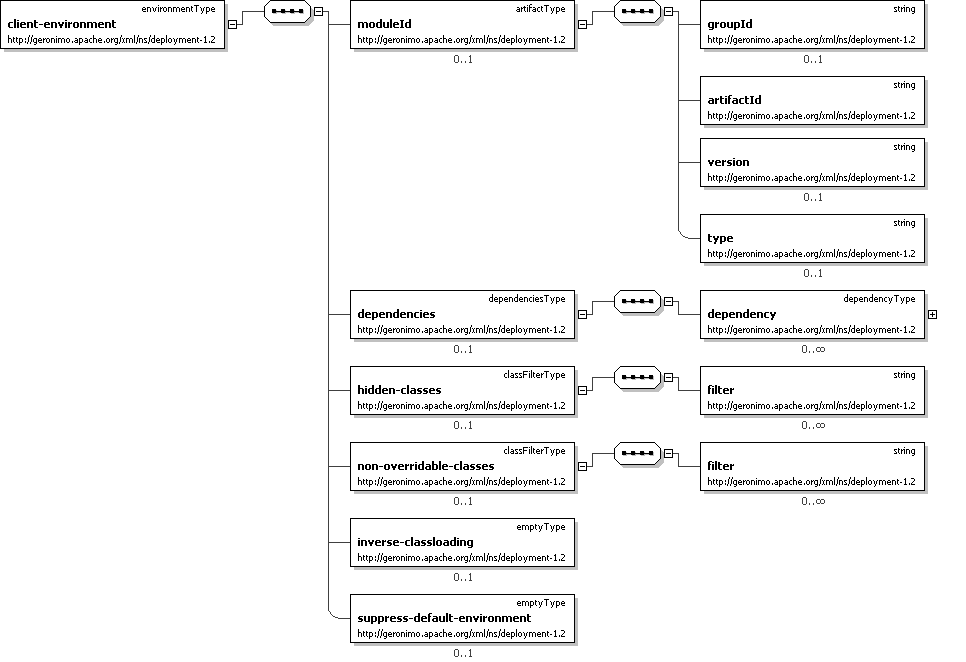
XML Instance Representation
<sys:client-environment>
<sys:moduleId>
sys:artifactType
</sys:moduleId> [0..1]
'"moduleId" holds elements for the groupId, artifactId, and version of the module version can be ommitted in which case a timestamp is used. Module IDs are normally printed with slashes between the four components, such as GroupID/ArtifactID/Version/Type.' <sys:dependencies>
sys:dependenciesType
</sys:dependencies> [0..1]
'"dependencies" holds all classloader and dependency information for the module' <sys:hidden-classes>
sys:classFilterType
</sys:hidden-classes> [0..1]
'A list of classes which will never be loaded from parent ClassLoaders of this module. For example, if Log4J was listed here, the module would never see Geronimo\'s copy of Log4J. If the module provided it\'s own Log4J JAR it would use that, otherwise it would not be able to load Log4J at all. The classes are specified in zero or more child \"filter\" elements where each filter element specifies a fully-qualified class name or prefix. Essentially, any class that starts with one of the prefixes listed here will be treated as hidden. For example, if you specify two filter elements containing \"java.util\" and \"java.lang\" then you would really screw up your application. :)' <sys:non-overridable-classes>
sys:classFilterType
</sys:non-overridable-classes> [0..1]
'A list of classes which will only be loaded from parent ClassLoaders of this module (never from the module\'s own ClassLoader). For example, this is used to prevent a web application from redefining \"javax.servlet\", so those classes will *always* be loaded from the server instead of from the web web application\'s own ClassPath. The classes are specified in zero or more child \"filter\" elements where each filter element specifies a fully-qualified class name or prefix. Essentially, any class that starts with one of the prefixes listed here will be treated as hidden. For example, specifying two filter elements containing \"javax.servlet\" and \"javax.ejb\" would protect some of the core J2EE classes from being overridden.' <sys:inverse-classloading>
sys:emptyType
</sys:inverse-classloading> [0..1]
'If the \"inverse-classloading\" element is specified, the standard class loading delegation model is to be reversed for this module.' <sys:suppress-default-environment>
sys:emptyType
</sys:suppress-default-environment> [0..1]
</sys:client-environment>'If the \"suppress-default-environment\" element is specified then any default environment build by a builder when deploying the plan will be suppressed. An example of where this is useful is when deploying a connector on an app client in a separate (standalone) module (not as part of a client plan). The connector builder defaultEnvironment includes some server modules that won\'t work on an app client, so you need to suppress the default environment and supply a complete environment including all parents for a non-app-client module you want to run on an app client'
Diagram
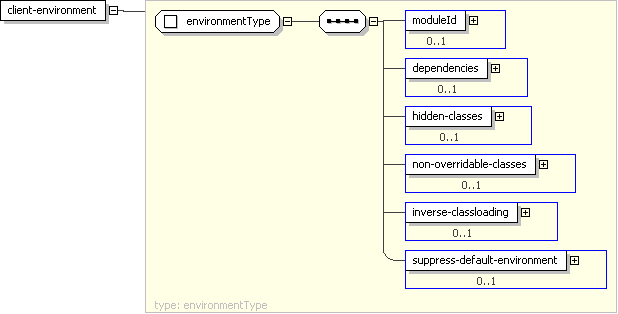
Schema Component Representation
Element: dependencies
Logical Diagram
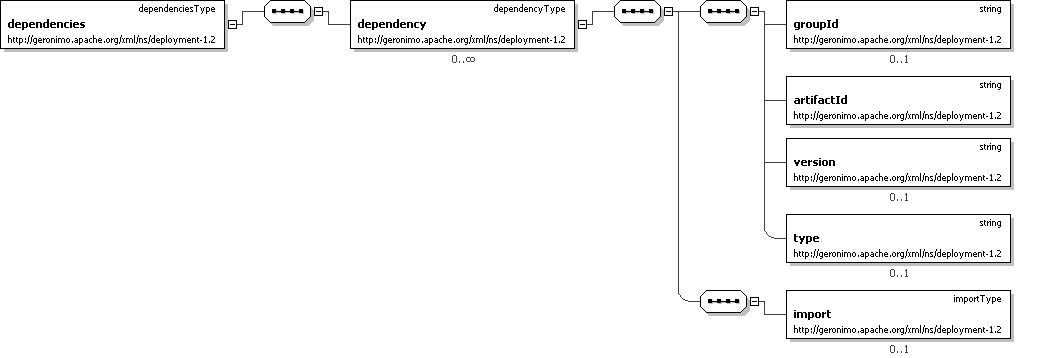
XML Instance Representation
<sys:dependencies>
<sys:dependency>
sys:dependencyType
</sys:dependency> [0..*]
</sys:dependencies>'"dependency" holds an artifact locating an artifact in a repository. Depending on the type of artifact and value of the import element, the artifact may be included in the current classpath, be loaded as a parent, may require the services in the artifact to be started, or may not be added to the classpath.'
Diagram

Schema Component Representation
Element: environment
Logical Diagram
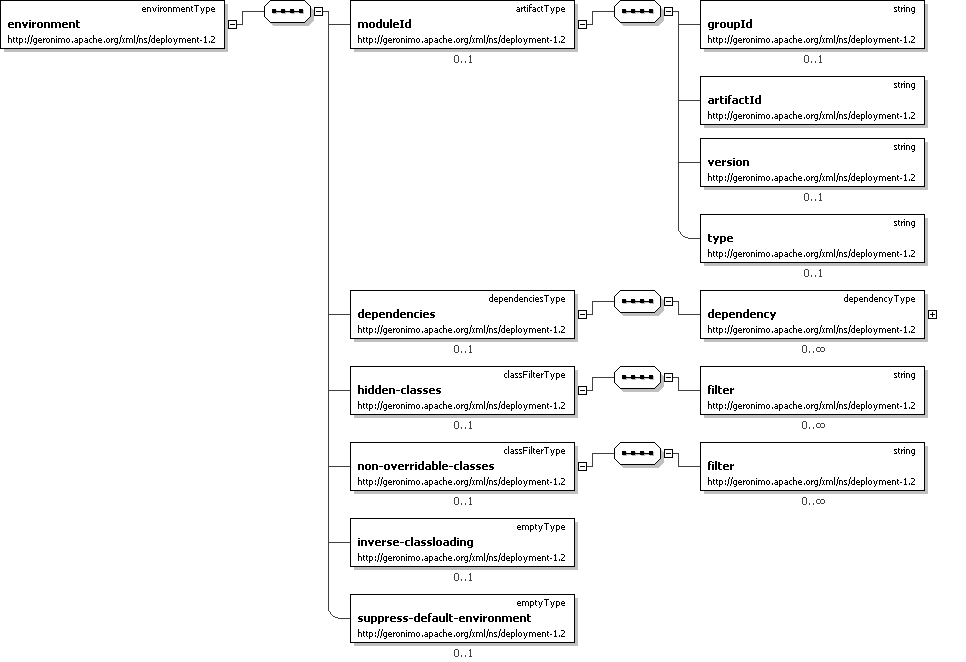
XML Instance Representation
<sys:environment>
<sys:moduleId>
sys:artifactType
</sys:moduleId> [0..1]
'"moduleId" holds elements for the groupId, artifactId, and version of the module version can be ommitted in which case a timestamp is used. Module IDs are normally printed with slashes between the four components, such as GroupID/ArtifactID/Version/Type.' <sys:dependencies>
sys:dependenciesType
</sys:dependencies> [0..1]
'"dependencies" holds all classloader and dependency information for the module' <sys:hidden-classes>
sys:classFilterType
</sys:hidden-classes> [0..1]
'A list of classes which will never be loaded from parent ClassLoaders of this module. For example, if Log4J was listed here, the module would never see Geronimo\'s copy of Log4J. If the module provided it\'s own Log4J JAR it would use that, otherwise it would not be able to load Log4J at all. The classes are specified in zero or more child \"filter\" elements where each filter element specifies a fully-qualified class name or prefix. Essentially, any class that starts with one of the prefixes listed here will be treated as hidden. For example, if you specify two filter elements containing \"java.util\" and \"java.lang\" then you would really screw up your application. :)' <sys:non-overridable-classes>
sys:classFilterType
</sys:non-overridable-classes> [0..1]
'A list of classes which will only be loaded from parent ClassLoaders of this module (never from the module\'s own ClassLoader). For example, this is used to prevent a web application from redefining \"javax.servlet\", so those classes will *always* be loaded from the server instead of from the web web application\'s own ClassPath. The classes are specified in zero or more child \"filter\" elements where each filter element specifies a fully-qualified class name or prefix. Essentially, any class that starts with one of the prefixes listed here will be treated as hidden. For example, specifying two filter elements containing \"javax.servlet\" and \"javax.ejb\" would protect some of the core J2EE classes from being overridden.' <sys:inverse-classloading>
sys:emptyType
</sys:inverse-classloading> [0..1]
'If the \"inverse-classloading\" element is specified, the standard class loading delegation model is to be reversed for this module.' <sys:suppress-default-environment>
sys:emptyType
</sys:suppress-default-environment> [0..1]
</sys:environment>'If the \"suppress-default-environment\" element is specified then any default environment build by a builder when deploying the plan will be suppressed. An example of where this is useful is when deploying a connector on an app client in a separate (standalone) module (not as part of a client plan). The connector builder defaultEnvironment includes some server modules that won\'t work on an app client, so you need to suppress the default environment and supply a complete environment including all parents for a non-app-client module you want to run on an app client'
Diagram
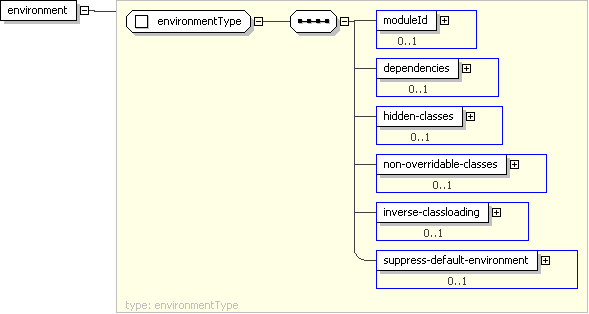
Schema Component Representation
<xs:element
name="environment" type="
sys:environmentType
">
<-- TODO figure out why this doesn't work
<xs:key name="name-key-key">
<xs:annotation>
<xs:documentation>
name-key-key assures that key-values for the names of services in this module will
have unique key names.
</xs:documentation>
</xs:annotation>
<xs:selector xpath="sys:name-key"/>
<xs:field xpath="sys:name-key/key"/>
</xs:key>
--> </xs:element>Element: gbean
Logical Diagram
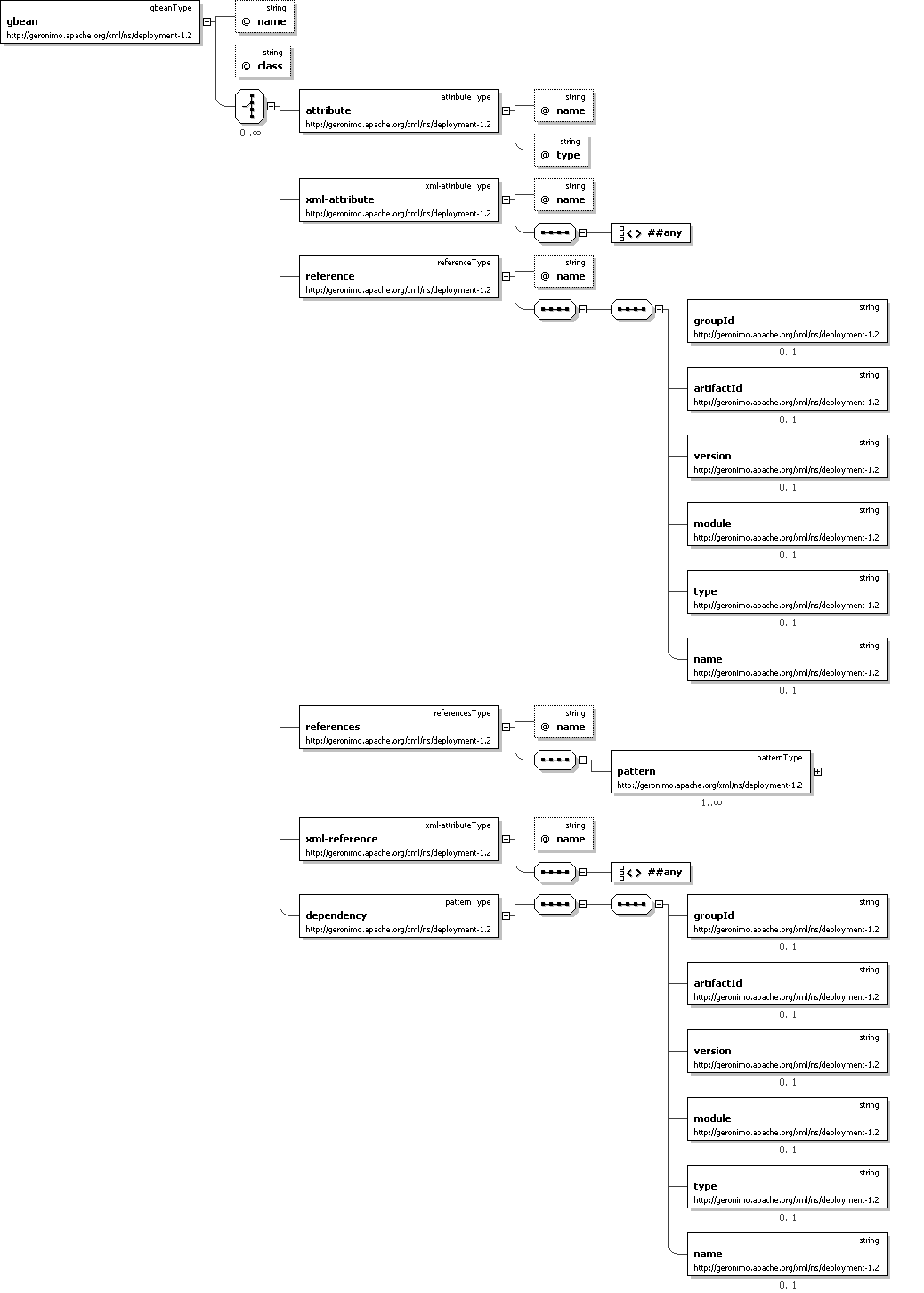
XML Instance Representation
<sys:gbean
name=" xs:string [1] 'A unique name for this GBean within this module, this name will be used as a name component in AbstractName, hence AbstractName will be unique server wide.' "class=" xs:string [1] 'The fully-qualified name of the class containing the GBeanInfo for this GBean.' ">Start Choice [0..*] <sys:attribute>
sys:attributeType
</sys:attribute> [1]
'The attribute provide the name-value pair of various attributes for this GBean. The value of the attributes is specified by value of this element.' <sys:xml-attribute>
sys:xml-attributeType
</sys:xml-attribute> [1]
'The xml-attribute specifies the value of particular attribute in XML format, which will be interpreted by a component running in the system, which convert it to single value for this attribute.' <sys:reference>
sys:referenceType
</sys:reference> [1]
'The \"reference\" element specifies the value of a particular reference for this GBean in simplest form. It holds the reference to the GBean that matches the single pattern specified here, if no value is specified it will refer to all the matching GBeans.' <sys:references>
sys:referencesType
</sys:references> [1]
'The \"references\" element specifies the value of a particular reference for this GBean matching multiple pattern elements.' <sys:xml-reference>
sys:xml-attributeType
</sys:xml-reference> [1]
'The xml-reference specifies the value of particular reference in XML format, which will be interpreted by a component running in the system, which convert it to single value for this reference.' <sys:dependency>
sys:patternType
</sys:dependency> [1]
End Choice
'The element \"dependency\" is used to resolve dependencies at GBean level. This is normally only used if for some reason the GBeans within a module must be started in a certain order that is not reflected in the references between them.' </sys:gbean>
Diagram

Schema Component Representation
Element: module
Logical Diagram

XML Instance Representation
<sys:module>
<sys:environment> ... </sys:environment> [1]
</sys:module>'Reference to environment element defined later in this xsd.'
Diagram

Schema Component Representation
Element: server-environment
Logical Diagram

XML Instance Representation
<sys:server-environment>
<sys:moduleId>
sys:artifactType
</sys:moduleId> [0..1]
'"moduleId" holds elements for the groupId, artifactId, and version of the module version can be ommitted in which case a timestamp is used. Module IDs are normally printed with slashes between the four components, such as GroupID/ArtifactID/Version/Type.' <sys:dependencies>
sys:dependenciesType
</sys:dependencies> [0..1]
'"dependencies" holds all classloader and dependency information for the module' <sys:hidden-classes>
sys:classFilterType
</sys:hidden-classes> [0..1]
'A list of classes which will never be loaded from parent ClassLoaders of this module. For example, if Log4J was listed here, the module would never see Geronimo\'s copy of Log4J. If the module provided it\'s own Log4J JAR it would use that, otherwise it would not be able to load Log4J at all. The classes are specified in zero or more child \"filter\" elements where each filter element specifies a fully-qualified class name or prefix. Essentially, any class that starts with one of the prefixes listed here will be treated as hidden. For example, if you specify two filter elements containing \"java.util\" and \"java.lang\" then you would really screw up your application. :)' <sys:non-overridable-classes>
sys:classFilterType
</sys:non-overridable-classes> [0..1]
'A list of classes which will only be loaded from parent ClassLoaders of this module (never from the module\'s own ClassLoader). For example, this is used to prevent a web application from redefining \"javax.servlet\", so those classes will *always* be loaded from the server instead of from the web web application\'s own ClassPath. The classes are specified in zero or more child \"filter\" elements where each filter element specifies a fully-qualified class name or prefix. Essentially, any class that starts with one of the prefixes listed here will be treated as hidden. For example, specifying two filter elements containing \"javax.servlet\" and \"javax.ejb\" would protect some of the core J2EE classes from being overridden.' <sys:inverse-classloading>
sys:emptyType
</sys:inverse-classloading> [0..1]
'If the \"inverse-classloading\" element is specified, the standard class loading delegation model is to be reversed for this module.' <sys:suppress-default-environment>
sys:emptyType
</sys:suppress-default-environment> [0..1]
</sys:server-environment>'If the \"suppress-default-environment\" element is specified then any default environment build by a builder when deploying the plan will be suppressed. An example of where this is useful is when deploying a connector on an app client in a separate (standalone) module (not as part of a client plan). The connector builder defaultEnvironment includes some server modules that won\'t work on an app client, so you need to suppress the default environment and supply a complete environment including all parents for a non-app-client module you want to run on an app client'
Diagram

Schema Component Representation
Element: service
Logical Diagram

XML Instance Representation
<sys:service/>
Diagram
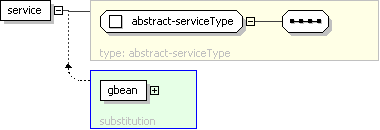
Schema Component Representation
Global DefinitionsComplex Type: abstract-serviceType
XML Instance Representation
<.../>
Diagram

Schema Component Representation
<xs:complexType
name="abstract-serviceType" abstract="true">
<xs:sequence/> </xs:complexType>Complex Type: artifactType
XML Instance Representation
<...>
<sys:groupId>
xs:string </sys:groupId> [0..1]
'The name for group containing this module. By default, it is considered \'default\' for declaration and wild card \'*\' for dependencies.' <sys:artifactId>
xs:string </sys:artifactId> [1]
'The name for module in a specified group. All the artifactId\'s should be unique within a group. If no articfactId is provided it will be defaulted to file name of the module file.' <sys:version>
xs:string </sys:version> [0..1]
</...>'The version number for the module formatted by dot separated numbers. If no version is provided it will be defaulted to numeric timestamp generated by System.currentTimeMillis() at deploy time. In case of dependencies latest available version will be used.'
Diagram
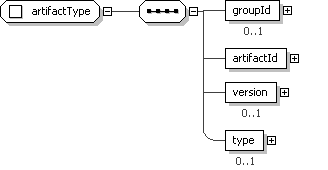
Schema Component Representation
<xs:complexType
name="artifactType">
<xs:sequence> </xs:complexType><-- TODO not sure if groupId can in fact be optional -->
</xs:sequence>Complex Type: attributeType
XML Instance Representation
Diagram

Schema Component Representation
Complex Type: classFilterType
XML Instance Representation
Diagram

Schema Component Representation
<xs:complexType
name="classFilterType">
<xs:sequence></xs:sequence> </xs:complexType>Complex Type: dependenciesType
XML Instance Representation
<...>
<sys:dependency>
sys:dependencyType
</sys:dependency> [0..*]
</...>'"dependency" holds an artifact locating an artifact in a repository. Depending on the type of artifact and value of the import element, the artifact may be included in the current classpath, be loaded as a parent, may require the services in the artifact to be started, or may not be added to the classpath.'
Diagram

Schema Component Representation
<xs:complexType
name="dependenciesType">
<xs:sequence></xs:sequence> </xs:complexType>Complex Type: dependencyType
XML Instance Representation
<...>
<sys:groupId>
xs:string </sys:groupId> [0..1]
'The name for group containing this module. By default, it is considered \'default\' for declaration and wild card \'*\' for dependencies.' <sys:artifactId>
xs:string </sys:artifactId> [1]
'The name for module in a specified group. All the artifactId\'s should be unique within a group. If no articfactId is provided it will be defaulted to file name of the module file.' <sys:version>
xs:string </sys:version> [0..1]
'The version number for the module formatted by dot separated numbers. If no version is provided it will be defaulted to numeric timestamp generated by System.currentTimeMillis() at deploy time. In case of dependencies latest available version will be used.' <sys:type>
xs:string </sys:type> [0..1]
'This element defines the type of the module. The type could be \'CAR\', \'JAR\', EAR\', \'WAR\', etc. If no type is provided it will be defaulted appropriately by the deployer depending upon type of deployed module.' <sys:import>
sys:importType
</sys:import> [0..1]
</...>'The import element is restrictive element to defined type of dependency. The default (when omitted) is to include the specified dependency in the classloader (as a parent or URL). If defined as \"classes\" means that the classes must be included in the current module\'s classloader but the dependency does not need to be started. Specifying \"services\" means that the dependency (a module) must be started before the current module, but it is not included as a parent classloader.'
Diagram

Schema Component Representation
<xs:complexType
name="dependencyType"></xs:complexType>
Complex Type: emptyType
XML Instance Representation
<.../>
Diagram

Schema Component Representation
<xs:complexType
name="emptyType"/>
Complex Type: environmentType
XML Instance Representation
<...>
<sys:moduleId>
sys:artifactType
</sys:moduleId> [0..1]
'"moduleId" holds elements for the groupId, artifactId, and version of the module version can be ommitted in which case a timestamp is used. Module IDs are normally printed with slashes between the four components, such as GroupID/ArtifactID/Version/Type.' <sys:dependencies>
sys:dependenciesType
</sys:dependencies> [0..1]
'"dependencies" holds all classloader and dependency information for the module' <sys:hidden-classes>
sys:classFilterType
</sys:hidden-classes> [0..1]
'A list of classes which will never be loaded from parent ClassLoaders of this module. For example, if Log4J was listed here, the module would never see Geronimo\'s copy of Log4J. If the module provided it\'s own Log4J JAR it would use that, otherwise it would not be able to load Log4J at all. The classes are specified in zero or more child \"filter\" elements where each filter element specifies a fully-qualified class name or prefix. Essentially, any class that starts with one of the prefixes listed here will be treated as hidden. For example, if you specify two filter elements containing \"java.util\" and \"java.lang\" then you would really screw up your application. :)' <sys:non-overridable-classes>
sys:classFilterType
</sys:non-overridable-classes> [0..1]
'A list of classes which will only be loaded from parent ClassLoaders of this module (never from the module\'s own ClassLoader). For example, this is used to prevent a web application from redefining \"javax.servlet\", so those classes will *always* be loaded from the server instead of from the web web application\'s own ClassPath. The classes are specified in zero or more child \"filter\" elements where each filter element specifies a fully-qualified class name or prefix. Essentially, any class that starts with one of the prefixes listed here will be treated as hidden. For example, specifying two filter elements containing \"javax.servlet\" and \"javax.ejb\" would protect some of the core J2EE classes from being overridden.' <sys:inverse-classloading>
sys:emptyType
</sys:inverse-classloading> [0..1]
'If the \"inverse-classloading\" element is specified, the standard class loading delegation model is to be reversed for this module.' <sys:suppress-default-environment>
sys:emptyType
</sys:suppress-default-environment> [0..1]
</...>'If the \"suppress-default-environment\" element is specified then any default environment build by a builder when deploying the plan will be suppressed. An example of where this is useful is when deploying a connector on an app client in a separate (standalone) module (not as part of a client plan). The connector builder defaultEnvironment includes some server modules that won\'t work on an app client, so you need to suppress the default environment and supply a complete environment including all parents for a non-app-client module you want to run on an app client'
Diagram
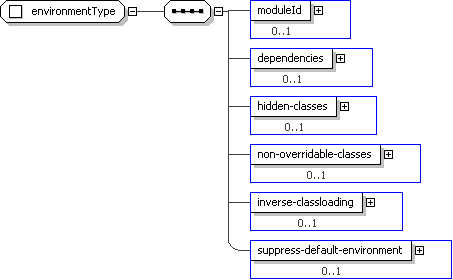
Schema Component Representation
<xs:complexType
name="environmentType">
<xs:sequence>
</xs:sequence> </xs:complexType>Complex Type: gbeanType
XML Instance Representation
<...
name=" xs:string [1] 'A unique name for this GBean within this module, this name will be used as a name component in AbstractName, hence AbstractName will be unique server wide.' "class=" xs:string [1] 'The fully-qualified name of the class containing the GBeanInfo for this GBean.' ">Start Choice [0..*] <sys:attribute>
sys:attributeType
</sys:attribute> [1]
'The attribute provide the name-value pair of various attributes for this GBean. The value of the attributes is specified by value of this element.' <sys:xml-attribute>
sys:xml-attributeType
</sys:xml-attribute> [1]
'The xml-attribute specifies the value of particular attribute in XML format, which will be interpreted by a component running in the system, which convert it to single value for this attribute.' <sys:reference>
sys:referenceType
</sys:reference> [1]
'The \"reference\" element specifies the value of a particular reference for this GBean in simplest form. It holds the reference to the GBean that matches the single pattern specified here, if no value is specified it will refer to all the matching GBeans.' <sys:references>
sys:referencesType
</sys:references> [1]
'The \"references\" element specifies the value of a particular reference for this GBean matching multiple pattern elements.' <sys:xml-reference>
sys:xml-attributeType
</sys:xml-reference> [1]
'The xml-reference specifies the value of particular reference in XML format, which will be interpreted by a component running in the system, which convert it to single value for this reference.' <sys:dependency>
sys:patternType
</sys:dependency> [1]
End Choice
'The element \"dependency\" is used to resolve dependencies at GBean level. This is normally only used if for some reason the GBeans within a module must be started in a certain order that is not reflected in the references between them.' </...>
Diagram

Schema Component Representation
<xs:complexType
name="gbeanType">
<xs:complexContent> </xs:complexType><xs:extension
base="
sys:abstract-serviceType
"> </xs:complexContent><xs:choice
minOccurs="0" maxOccurs="unbounded">
</xs:choice>
</xs:extension>Complex Type: moduleType
XML Instance Representation
<...>
<sys:environment> ... </sys:environment> [1]
</...>'Reference to environment element defined later in this xsd.'
Diagram

Schema Component Representation
<xs:complexType
name="moduleType">
<xs:sequence>
</xs:sequence> </xs:complexType>Complex Type: patternType
XML Instance Representation
<...>
<sys:groupId>
xs:string </sys:groupId> [0..1]
'The name for group containing module to match. By default is it considered wild card \'*\'.' <sys:artifactId>
xs:string </sys:artifactId> [0..1]
'The name for module in a specified group to be matched.' <sys:version>
xs:string </sys:version> [0..1]
'The version number for the module formatted by dot separated numbers. If no version is provided it will be defaulted latest available version matching other criterions.' <sys:module>
xs:string </sys:module> [0..1]
</...>'The value specified here should match the file name of the module referenced.'
Diagram
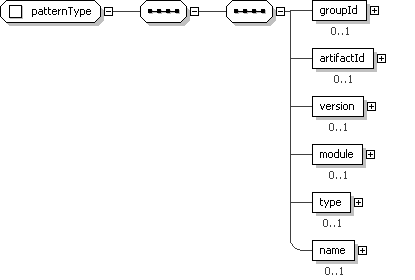
Schema Component Representation
<xs:complexType
name="patternType">
<xs:sequence> </xs:complexType><xs:sequence>
</xs:sequence> </xs:sequence>Complex Type: referenceType
XML Instance Representation
<...
name=" xs:string [0..1] 'The name for the current reference. This name should be same as specified in GBeanInfo for this GBean.' "><sys:groupId>
xs:string </sys:groupId> [0..1]
'The name for group containing module to match. By default is it considered wild card \'*\'.' <sys:artifactId>
xs:string </sys:artifactId> [0..1]
'The name for module in a specified group to be matched.' <sys:version>
xs:string </sys:version> [0..1]
'The version number for the module formatted by dot separated numbers. If no version is provided it will be defaulted latest available version matching other criterions.' <sys:module>
xs:string </sys:module> [0..1]
</...>'The value specified here should match the file name of the module referenced.'
Diagram

Schema Component Representation
<xs:complexType
name="referenceType"></xs:complexType>
Complex Type: referencesType
XML Instance Representation
<...
name=" xs:string [0..1] 'The name for the current reference. This name should be same as specified in GBeanInfo for this GBean.' "><sys:pattern>
sys:patternType
</sys:pattern> [1..*]
</...>'The pattern used for matching the referenced GBean.'
Diagram

Schema Component Representation
<xs:complexType
name="referencesType">
<xs:sequence></xs:sequence>
</xs:complexType>Complex Type: xml-attributeType
XML Instance Representation
<...
name=" xs:string [0..1] 'The name for the current attribute. This name should be same as specified in GBeanInfo for this GBean.' ">Allow any elements from any namespace (lax validation). [1]
</...>
Diagram

Schema Component Representation
<xs:complexType
name="xml-attributeType">
<xs:sequence>
</xs:complexType><xs:any
namespace="##any" processContents="lax"/> </xs:sequence>Simple Type: importType
Diagram

Schema Component Representation
<xs:simpleType
name="importType">
<xs:restriction
base="
xs:string
"> </xs:simpleType><xs:enumeration
value="classes"/>
<xs:enumeration
value="services"/> </xs:restriction>LegendComplex Type:Schema Component Type
AusAddressSchema Component Name
If this schema component is a type definition, its type hierarchy is shown in a gray-bordered box.
The table above displays the properties of this schema component.
XML Instance Representation
<...
country="Australia"
>
<unitNo> string </unitNo> [0..1] <houseNo> string </houseNo> [1] <street> string </street> [1] Start Choice [1] <city> string </city> [1] <town> string </town> [1] End Choice <state> AusStates </state> [1] <postcode> string <<pattern = [1-9][0-9]{3}>> </postcode> [1] ? </...> The XML Instance Representation table above shows the schema component's content as an XML instance.
Schema Component Representation
<complexType
name="AusAddress">
<complexContent> <extension base=" Address "> <sequence> <element name="state" type=" AusStates "/> <element name="postcode"> <simpleType> <restriction base=" string "> <pattern value="[1-9][0-9]{3}"/> </restriction> </simpleType> </element> </sequence> <attribute name="country" type=" string " fixed="Australia"/> </extension> </complexContent> </complexType> The Schema Component Representation table above displays the underlying XML representation of the schema component. (Annotations are not shown.)
GlossaryAbstract (Applies to complex type definitions and element declarations). An abstract element or complex type cannot used to validate an element instance. If there is a reference to an abstract element, only element declarations that can substitute the abstract element can be used to validate the instance. For references to abstract type definitions, only derived types can be used. All Model Group Child elements can be provided in any order in instances. See: http://www.w3.org/TR/xmlschema-1/#element-all. Choice Model Group Only one from the list of child elements and model groups can be provided in instances. See: http://www.w3.org/TR/xmlschema-1/#element-choice. Collapse Whitespace Policy Replace tab, line feed, and carriage return characters with space character (Unicode character 32). Then, collapse contiguous sequences of space characters into single space character, and remove leading and trailing space characters.
Disallowed Substitutions
(Applies to element declarations). If substitution is specified, then substitution group members cannot be used in place of the given element declaration to validate element instances. If derivation methods, e.g. extension, restriction, are specified, then the given element declaration will not validate element instances that have types derived from the element declaration's type using the specified derivation methods. Normally, element instances can override their declaration's type by specifying an Key Constraint Like Uniqueness Constraint, but additionally requires that the specified value(s) must be provided. See: http://www.w3.org/TR/xmlschema-1/#cIdentity-constraint_Definitions. Key Reference Constraint Ensures that the specified value(s) must match value(s) from a Key Constraint or Uniqueness Constraint. See: http://www.w3.org/TR/xmlschema-1/#cIdentity-constraint_Definitions. Model Group Groups together element content, specifying the order in which the element content can occur and the number of times the group of element content may be repeated. See: http://www.w3.org/TR/xmlschema-1/#Model_Groups.
Nillable
(Applies to element declarations). If an element declaration is nillable, instances can use the Notation A notation is used to identify the format of a piece of data. Values of elements and attributes that are of type, NOTATION, must come from the names of declared notations. See: http://www.w3.org/TR/xmlschema-1/#cNotation_Declarations. Preserve Whitespace Policy Preserve whitespaces exactly as they appear in instances. Prohibited Derivations (Applies to type definitions). Derivation methods that cannot be used to create sub-types from a given type definition. Prohibited Substitutions (Applies to complex type definitions). Prevents sub-types that have been derived using the specified derivation methods from validating element instances in place of the given type definition. Replace Whitespace Policy Replace tab, line feed, and carriage return characters with space character (Unicode character 32). Sequence Model Group Child elements and model groups must be provided in the specified order in instances. See: http://www.w3.org/TR/xmlschema-1/#element-sequence. Substitution Group Elements that are members of a substitution group can be used wherever the head element of the substitution group is referenced. Substitution Group Exclusions (Applies to element declarations). Prohibits element declarations from nominating themselves as being able to substitute a given element declaration, if they have types that are derived from the original element's type using the specified derivation methods. Target Namespace The target namespace identifies the namespace that components in this schema belongs to. If no target namespace is provided, then the schema components do not belong to any namespace. Uniqueness Constraint Ensures uniqueness of an element/attribute value, or a combination of values, within a specified scope. See: http://www.w3.org/TR/xmlschema-1/#cIdentity-constraint_Definitions. |